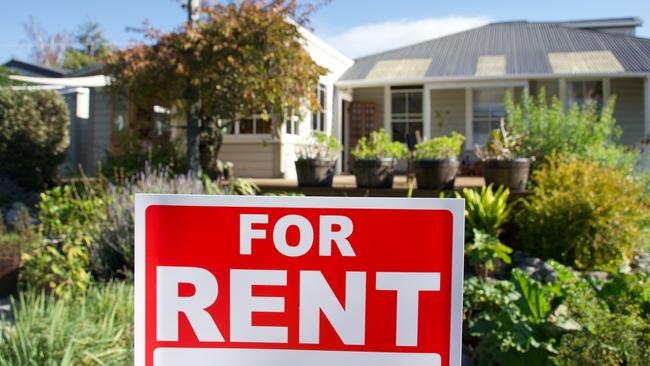Why the rental crisis is making the RBA’s job more difficult
Australia’s housing affordability crisis is driving a surge in the cost of rent that’s making the Reserve Bank’s job more difficult.

Business
Don't miss out on the headlines from Business. Followed categories will be added to My News.
The housing affordability crisis is driving a surge in the cost of rent that will continue to underpin inflation for at least two more years, according to Jarden Securities.
Surging migration, record low rental vacancies, subdued housing investment and strong growth in aggregate income from a tight labour market has resulted in the strongest rental price growth in decades.
While many financial institutions including the big four banks expect the Reserve Bank to cut rates in November if inflation keeps falling and a nascent economic downturn gathers pace, Jarden says the rapid increase in rents will limit the fall in inflation, posing a “challenge” for the Reserve Bank as it seeks to lower inflation to its 2-3 per cent target band.
“Australia is in the midst of a housing affordability crisis,” Jarden chief economist Carlos Cacho said.
In his view, there’s a crisis in the rental market as well as the market for established and new homes.
A 7.8 per cent year-on-year rise in the cost of rent measured in the consumer price index for the March quarter was the strongest rise since 2009, according to the Australian Bureau of Statistics.
The cost of rent has soared more than 30 per cent since 2019.
But given the lags involved between observing changes in market rents or “asking” rents and the recording of rental changes in the official inflation data, which measures the average of all rents, Mr Cacho said this inflation category would accelerate to 10 per cent this year before falling to 8 per cent next year, even as market rents had probably already peaked after surging 10 per cent on-year.
“With rents the second-largest item in the CPI basket, this is likely to maintain upward pressure on inflation and will likely remain a challenge for the RBA,” he said.
RBA assistant governor Sarah Hunter this week said there was no “quick fix” for the housing crisis. Dr Hunter said an imbalance between the supply of new housing and demand for housing was pushing up rents and construction costs and had implications for economic activity.
In a speech on housing market cycles and fundamentals at the Real Estate Institute of Australia’s Centennial Congress in Hobart, the top economist at the central bank said strong housing demand would keep putting “upward pressure” on rents and prices until new supply came online.
“We expect this response to take some time to materialise, given the current level of new dwelling approvals and the information from liaison that many projects are still not viable,” Dr Hunter said.
Jarden’s Mr Cacho said that over the medium to longer term, household income had been the key driver, with rents as a share of income remaining largely stable over much of the last three decades.
But an imbalance between demand and supply was now the key driver of rents.
“Before the Covid pandemic, Sydney, Melbourne and Brisbane all saw very subdued or even negative rent growth as a surge in unit construction pushed up vacancy rates,” he said.
“Today the opposite is occurring, with an increase in rental demand – combined with very weak new supply – seeing record low rental vacancy rates and surging rents, albeit it’s partly a catch-up.”
Surging demand for rentals in recent years was initially driven by people forming smaller households, with a fall in household size from 2020 to 2022 increasing demand for dwellings by 120,000. But once the borders reopened, the surge in migration had further increased demand.
Australia has seen net overseas migration of 750,000 since June 2022.
Mr Cacho said he expected an increase in average household size – as renters move back in with friends and family or take on housemates – to play a part in managing higher rents and challenging affordability.
The RBA has estimated that if average household size rose back to 2.8, Australia would need 1.2 million fewer dwellings to house its current population.
A recent 10 per cent growth rate in market rents was the strongest growth since 2008.
Jarden’s Mr Cacho said he expected the annual growth rate of market rents to slow to 8.5 per cent this year and 4.3 per cent in 2025. But given the lag between market rents and rents within the CPI, it would take about 18 months for a slowdown in market rents to show up in the CPI.
“Given this, we expect CPI rents to rise 10 per cent over 2024, and 8 per cent over 2025,” he said. Rents are expected to add 60 basis points to inflation this year, and 50 points in 2025
In its latest economic forecasts, the central bank predicted that consumer price index inflation would almost hit the midpoint of its inflation target by the middle of 2026.
But it assumed “market pricing” for the cash rate target, which implied it would stay at a 12-year high of 4.35 per cent until the middle of next year, before declining to about 3.8 per cent by the middle of 2026.
Jarden expects the RBA to cut the cash rate three times between May next year and the end of 2025 as the economy slows. That would lower the cash rate to 3.6 per cent, which is in line with Jarden’s estimate of the “neutral” policy rate.
“While the government has introduced further rental assistance for financial year 2025, we expect the underlying drivers of rents to persist, keeping rental growth elevated,” Mr Cacho said.
“Ultimately, we see the strong rise in rents, along with broader services inflation, as the main drivers of inflation over the next two years.”
Originally published as Why the rental crisis is making the RBA’s job more difficult



